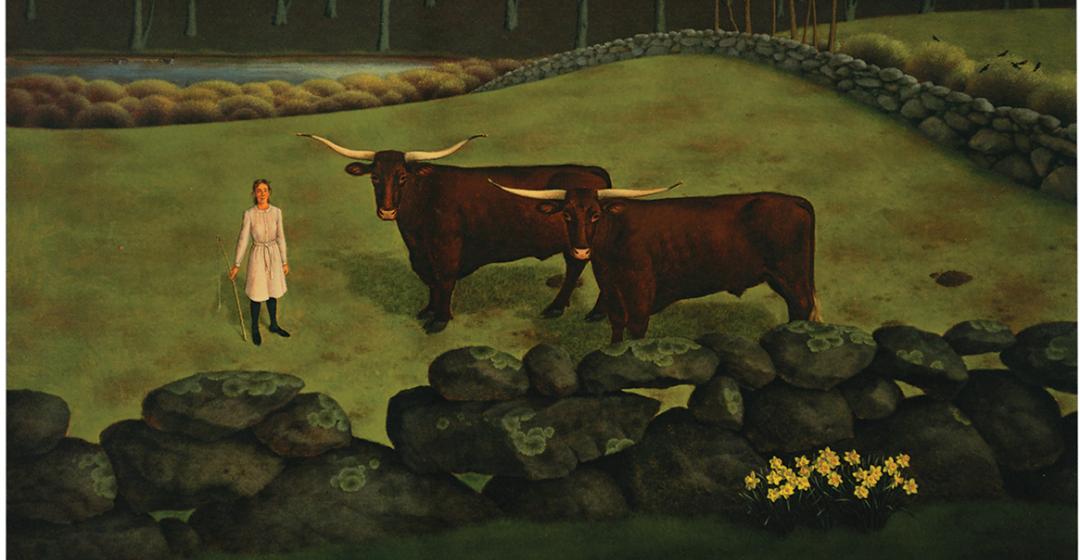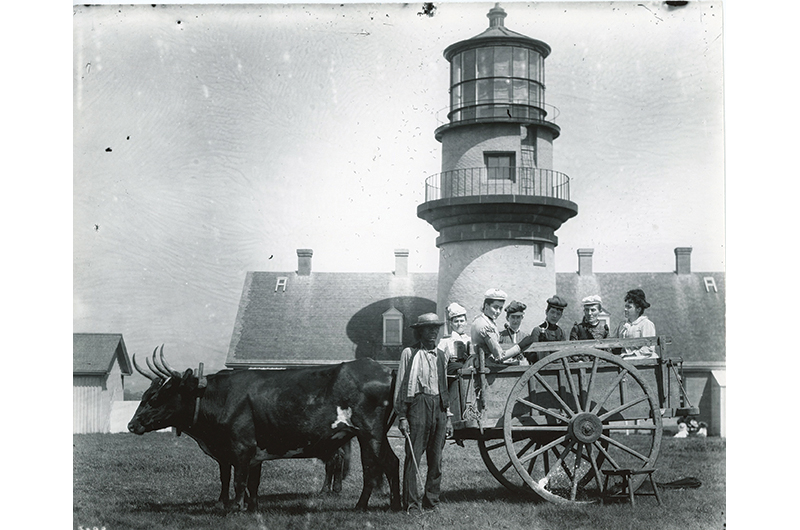More than forty years ago, a pair of handsome young Red Devon milking oxen came to live on a small farm on Middle Road in Chilmark named Brookside, a site overlooking the waters of the Tiasquam River. The oxen, who were known as Buck and Shorty, spent their days in quiet leisure, sleeping in the shade of a cluster of oak trees or grazing in a big field that was visible from the road.
Given their mammoth size and their extraordinarily wide and curved white horns, almost immediately Buck and Shorty drew the attention and affection of neighbors and tourists and anyone happening by in a car or on a bike or on foot. Local dignitaries, they were sights to be seen. The celebrated Island artist Stan Murphy, who lived on the adjoining property, painted a portrait of the oxen in training with their young caretaker, Hilary Blocksom, who had bought the pair because she wanted to learn how to train and show them. Murphy’s painting now hangs in the Chilmark library, reminding the town of its past.
Only for a few days in August did the pair ever leave their field at Brookside, following Blocksom down Middle Road to the annual Agricultural Fair in West Tisbury, where they won blue ribbons for their breed and best performance in the ever- popular ox-pull. When Buck and Shorty died in the 1990s, at the ages of twenty-three and twenty-four, their absence from Brookside was heavy and the emptiness of the big field startling.
In the early 2000s, a new pair named Buddy and Boy took the helm at the farm. Guided by Blocksom, they, too, won blue ribbons at the annual fair. Over the years, admiring passersby submitted hundreds of their own images of the oxen to social media, even climbing on the farm’s stone wall to secure a better view. Though last year Buddy and Boy died, this time the big field wouldn’t be empty for long.
On October 22, 2022, the day of the Harvest Festival at the Agricultural Hall, two young Red Devons appeared again under the sun at Brookside, freshly arrived, by truck and barge, from the family farm of their breeder, Mark Winslow, in West Falmouth, Maine. Winslow had convinced Mark Gimbel, who inherited Brookside and was missing Buddy and Boy, of the extraordinary history of the breed, and its felicitous place on an historic Vineyard farm. On view for the first time, the pair of four-year-olds, relative youngsters named Pete and Bub, idled calmly and munched on a mound of local grasses, their coats glowing reddish in the afternoon light (hence the breed’s nickname “Ruby Reds”), their horns tipped in brown, luminous and astonishing.
Red Devon Milking Cattle, the official name of the breed, originally came to America from Devon, England, imported in the 1600s by the first wave of colonists after the Mayflower, and a century later in the 1790s, by Winslow’s ancestors. In turn, for a while, the colonists exported vessels full of the butter and cheese products of the young cattle. (Technically, male cattle are called steers after they are castrated, and only become oxen when they are yoked and trained as draft animals.) Most famously in the history of the breed, George Washington, foremost in his own mind a dedicated farmer, brought a sloop full of some 166 Red Devons to these shores for use at Mount Vernon in Virginia. Such was the fame of these highly pedigreed oxen, who were well suited for work in the rolling and rocky fields of New England as well as for the many chores on the plantations of the Old South. “They are a multipurpose breed,” Winslow says. “They are easy to work with, slow but strong and steady pulling carts and machines, intelligent and cooperative with their trainers if those trainers are kind. Quite remarkably, since they first came to this country 400 years ago, the breed has stayed the same.”
It was once estimated that, in the early days, there were at least one or two or several pairs of oxen per farmer on the Vineyard and a variety of breeds: Guernsey, Durham, Holstein, Jersey, as well as mixed breeds and the Red Devons. (In the milking house at Brookside, a well-worn yoke hangs near a photograph of a pair of Guernsey who had once worked the land.) But after the Industrial Revolution and the invention of the combustion engine, where there had once been only oxen to work, there were now tractors and mowers, motor trucks and planters and harvesters, and, eventually, cars.
In 1954, the Hornblower estate in Chilmark sold its last pair of oxen, leaving perhaps only a team in Vineyard Haven owned by Craig Kingsbury, as surmised by the Vineyard Gazette. Though the fate of those oxen is not known, ten years later the Gazette reported that the last pair of oxen on the Island had officially sold – these owned by Granville “Jack” Belain, a member of the Wampanoag Tribe of Gay Head (Aquinnah).
The sale of the pair elicited the boldface headline “OXEN SOLD,” and the long article that followed was a heartfelt commemoration of the end of an era, spanning a multitude of years, during which “the island had been maintained in whole, or part, by working steers,” its editor wrote. Over the centuries, this had meant not only tilling and planting and mowing and earthmoving, but also cutting forests and uprooting stumps, excavating boulders and building stone walls, opening ponds to the sea, and moving houses and barns to new locations, sometimes, across the Island. It was a vast achievement, which lives on in the lay of the land and in tales told by generations of farmers about the long and happy relationship between man and oxen.
Belain, a much-loved local, had set a new business in motion in the 1960s by traveling the roads of Gay Head (now Aquinnah) with his wife, Nellie, at his side and his oxcart packed with handicrafts and wares to sell to tourists. The business brought to mind a time, late in the nineteenth century, when the Martha’s Vineyard ferry company was still running excursions to Gay Head in a side-wheeler steamboat. The collection of oxcarts met the boat and conducted tours of surrounding parts of the town – the “Indian village,” the lighthouse, the cliffs – another early arm of the tourist trade. As seen in a postcard from the time, the scene was a happy mêlée that filled the big field near the lighthouse: drivers and oxen and carts full of ladies in ruffles and flat straw hats, kids in motion and festivity in the air.
Over the years, Belain had taught other members of the Tribe the finer points of hooking up a cart and how to train their oxen for farmwork as well as travel. He was a kind and generous man who didn’t really mind when kids jumped into the back of his cart to hitch a ride up to their playground on the cliffs. On the Wampanoag holiday known as Cranberry Day, Belain was the one who led the way to the Menemsha/Lobsterville area in his oxcart, as had long been the custom, pulling a sled behind to hold his skiff for scalloping in Menemsha Bay, and devoting the rest of the day to picking berries in the bogs and celebrating the traditions of the harvest.
It is a long way back to the old-time Vineyard, but its stories continue to inform and linger like important memories. The presence of two massive and majestic Red Devons in the fields of Brookside again seems like a magical connection to the past, part sideshow and, more importantly, a lesson in Island history. These days the sight of an ox and cart, plodding down State Road and slowing traffic, brings a nostalgic smile; the tale of a woman who regularly took her ox team to the drive-thru at the bank, lives on. In retrospect, the whole crowd of farmers who worked with and honored their oxen now seem like one big special and congenial family, a collection of latter-day founding fathers, sons, and brothers, Athearns, Woodruffs, Kingsburys, Fischers, Vanderhoops, and more; they all played their parts in the growth of the Island. Oxen had been not only their labor force, but for a while, their constant companions and best friends. Their slow but steady strides had taught the owners patience and persistence, their warm and strapping bodies, the big eyes and amiable faces had made them irresistible.
In 1999, Blocksom, who has long been an active member of the Martha’s Vineyard Agricultural Society, added a new and larger event for oxen to the annual fair. She describes herself as retired now, although she keeps a watchful eye on Pete and Bub at Brookside and speaks frequently with Ben Cabot and his fourteen-year-old daughter, Reed, who now oversee the lives and training of the “boys” at the farm. Ben and Reed make a graceful and appealing pair. And the oxen have responded to their warmth and their easy voices. “Step, step, stop, step, slow down, whoa,” they command as they walk alongside their charges, using a light tap on the back or the chest with the thin wand-like sticks they carry to indicate direction. Blocksom remembers her own youthful days on the field with obvious pleasure as well as pride. “I was young and innocent then,” she says, “and I immediately fell in love with oxen.” Flashing a broad and convincing smile, she adds, “They are the sweetest things.”





 1 comment
1 comment
Comments (1)